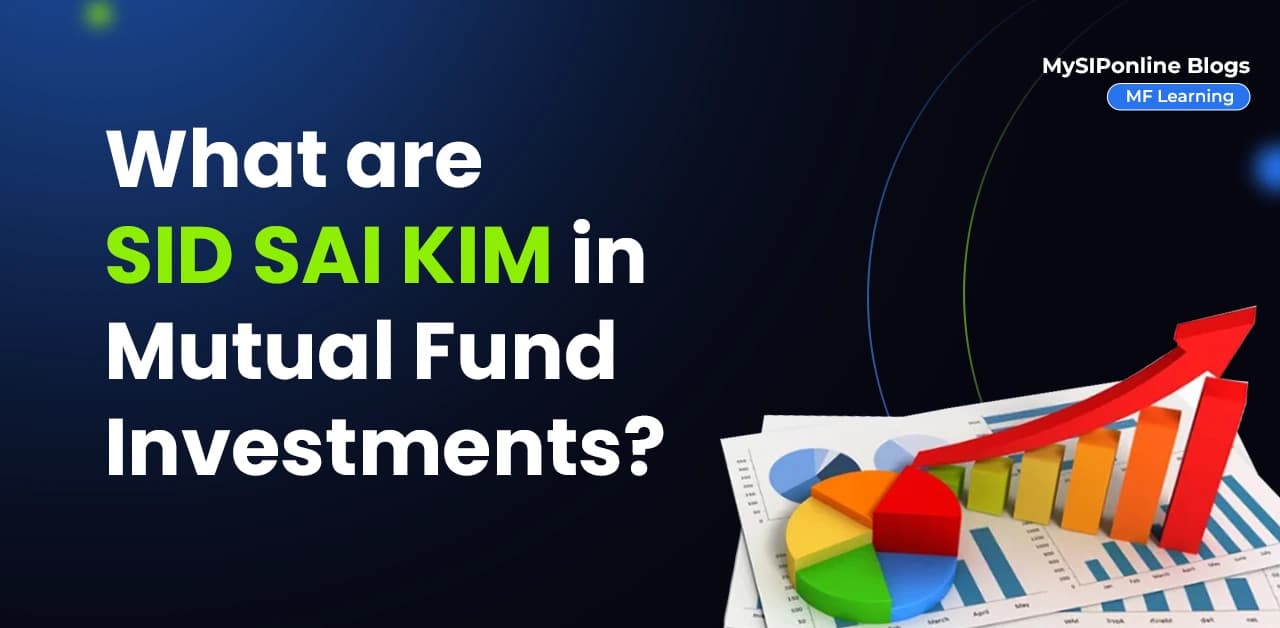Table of Contents
Did you know when you are investing in Mutual Funds, knowledge is power? Yes, one of the driving forces that will lead you to a successful portfolio in 2025 is making informed decisions based on "Scheme Related Documents" also known as Offer Documents (ODs), and how to read them especially when it comes to understanding the SID SAI KIM in mutual fund investments.
Every mutual fund has three important documents that are prepared by respective AMCs to provide crucial information about a particular scheme. These documents are approved by the Securities and Exchange Board of India (SEBI).
These documents include the Scheme Information Document (SID), Statement of Additional Information (SAI), and Key Information Memorandum (KIM). Together, they offer the details an investor needs before committing to a mutual fund scheme.
Let’s break down these terms individually so you can get a clearer understanding and make smarter investment choices in 2025.
What is SID in Mutual Fund?
The SID full form in mutual fund is 'Scheme Information Document'. It provides the basic information about a particular scheme, which you should know before investing. So, here are some important points which are specifically mentioned in the SID of a scheme:
- Investment Objective & Strategy: The SID outlines the fund's primary goal, whether it is capital appreciation, income generation or a blend of both. It also explains the strategy the fund will use to achieve this goal, including the type of assets it will invest in.
- Asset Allocation Pattern: One of the most important sections of the SID is the Asset Allocation Pattern. This shows the breakdown of the fund’s investments. For example, the percentage allocated to equities, debt or money market instruments.
- Risk Factors: Every mutual fund carries a certain level of risk. The SID in mutual fund shows the risk factors connected with the scheme. It includes various types of risk like market risk, interest rate risk and liquidity risk. Understanding these risk factors helps you match your desired goals with the fund's objectives.
- Past Performance: While past performance doesn’t guarantee future results, the SID provides historical returns and comparisons with a relevant benchmark, helping you assess the fund’s track record.
- Fund Manager’s Details: Information about the fund manager, their experience and track record is also part of the SID, as the expertise of the manager plays a very important role in the performance of the fund.
- Expenses, Loads and Fees: The SID also outlines the charges you’ll incur, including the expense ratio, entry loads, exit loads and any other fees associated with the fund. These expenses impact your overall returns and should be considered carefully.
- Tax Implications: As per the type of mutual fund, the SID will provide information on tax implications. Now, whether it is tax-saving funds (ELSS) or debt funds, the taxation is applied according to the new tax regime.
Important Read: Taxation on Mutual Fund Comparison Old vs New Tax Regime
What is SAI in Mutual Fund?
The SAI full form in mutual fund stands for Statement of Additional Information. This document provides supplementary information about the fund house and the mutual fund’s operational details. It’s more about the AMC (Asset Management Company), its structure and the legal aspects of the fund, rather than specific scheme information.
Let's see the key features of the statement of additional information:
-
AMC Board & Governance
The SAI gives details about the Asset Management Company (AMC) that manages the fund. It talks about the board of directors and the company's management practices, helping investors know who is running the fund and if they are trustworthy.
-
Investment Restrictions
It explains the types of investments the fund cannot make. For example, some funds may not invest in certain sectors or risky assets. This section helps you understand what the fund can and cannot do with your money.
-
Investor Rights and Services
The SAI in mutual funds explains the rights that investors have, like how to sell their units (redeem) or get more information about their investment. It tells you what services the fund offers to investors.
-
Financial Information
The piece of document carries important details of your finances like the fund’s balance sheet. This gives you a sense of how financially healthy the fund is and whether it’s well-managed.
-
Distribution and Practices
It involves how the fund’s units are sold to investors, the commissions involved and the overall practices of the AMC in distributing the fund.
-
Additional Information
The SAI has your legal information, such as changes made to the fund’s operations. While this might not be directly relevant for most investors, it ensures the fund follows all the rules set by regulatory authorities. The SAI is called ‘Part B’ of the fund’s registration documents. The fund must provide a copy of the SAI if you ask for it, and it’s free of charge.
In simple terms, the SAI provides a detailed view of how the mutual fund is managed, its financial health and its rules. It gives you more insight than the SID, which focuses mainly on the fund’s investments.
What is KIM in Mutual Fund?
The KIM full form in mutual fund is the Key Information Memorandum. As the name suggests, the KIM is a summarized, easy-to-read version of the SID. It’s designed for investors who need quick and concise information about a scheme without wading through the entire SID.
The key highlights of KIM (key information memorandum):
- Basic Scheme Information: The KIM covers the core details like the scheme’s investment objective, asset allocation and top holdings.
- Fund Manager Details: It includes a brief about the fund manager’s background and track record.
- Risk Profile: The KIM in mutual fund provides a simplified version of the risk factors mentioned in the SID, so you can quickly understand the level of risk involved in the scheme.
- Expenses and Loads: The expenses and entry and exit loads are clearly given in the KIM. This helps you quickly assess the cost-effectiveness of the scheme.
- Scheme Type: The KIM also specifies whether the scheme is Equity, debt, hybrid or another type, giving you a quick snapshot of the investment style.
For those who prefer a quicker glance at essential scheme details, the KIM in mutual fund offers a snapshot of the information you will find in the SID and SAI. The KIM in mutual funds is attached to the application form for easy access.
Why Should You Read the SID, SAI and KIM?
Here are some important points to note:
-
Make Informed Investment Decisions
These documents help you understand the mutual fund clearly. Whether you are new to investing or have experience, reading the SID in mutual funds, SAI and KIM ensures you know exactly what the fund is about before you invest your money.
-
Avoid Misleading Information
Sometimes, advertisements or marketing materials can make a fund sound better than it really is. By reading the SID, you get honest, detailed facts about the fund’s goals, risks, and past performance. This way you can avoid making mistakes based on incomplete or misleading information.
-
Check if the Fund Matches Your Goals
Every mutual fund has different goals. By reading the SID, SAI, and KIM, you can make sure that the fund fits with your own financial goals, how much risk you are willing to take, and how long you plan to invest.
-
Track Fund Performance & Manager’s Skills
The SID shows how the fund has performed in the past and gives information about the fund manager's experience. This helps you decide if the fund has the potential to meet your expectations.
-
Understand Fees & Costs
The SID also tells you about the fund’s fees, like the expense ratio and exit loads. Knowing these costs helps you understand how much the fund will cost you in the long run, so you can compare different funds and choose the one that’s right for you.
In simple terms, reading these documents ensures you have all the facts and are making an informed choice before you invest your money.
Where Can You Find SID, SAI and KIM?
All these documents are readily available online. You can go to the Asset Management Company's (AMC) official website, where you have made your investment. They are typically available as downloadable PDFs for your reference. You can also directly contact the AMC for a physical copy of these documents if needed.
Final Note
In short, it can be said that an investor should know the whereabouts of the fund, which is available in the form of ‘Scheme Related Documents’. They are provided with detailed knowledge about the fund and related terms & policies. The ‘Scheme Related Documents, i.e., SID, SAI & KIM of any particular mutual fund are available on the website of SEBI and particular AMC.
All in all the best strategy to invest in a fund is via SIP (Systematic Investment Plan) for higher returns in the long term.
Mutual Funds Related Blogs :









.webp&w=3840&q=75)



